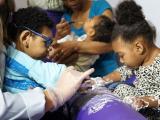A survey to assess the capacity that local health departments have for responding to Zika infections in pregnant women found high levels of involvement in activities to protect maternal and child health, such as connecting women and babies to services they need, but with some room for improvement.
The survey was conducted from July through September of 2017 by the National Association of County and City Health Officials (NACCHO), in partnership with the US Centers for Disease Control and Prevention (CDC) and the National Center on Birth Defects and Developmental Disabilities. The online survey targeted local health departments in 10 high-priority states based on the presence of mosquitoes that spread the disease or their high numbers of travel-related Zika cases: Alabama, Arizona, California, Florida, Georgia, Hawaii, Louisiana, Mississippi, New York, and Texas.
In a press release yesterday, NACCHO said the results from the study are important, because they underscore the need for continued federal funding, which is at risk, because Congress has proposed eliminating the Prevention and Public Health Fund, which helps fund local health departments through the CDC.
Laura Hanen, MPP, NACCHO's interim executive director and chief of government affairs, said in the statement that, according to CDC data, Zika-linked birth defects increased 21% in areas with local transmission in the second half of 2016 compared with the first half of the year, showing an urgent need for local health departments to increase their capacity to address the cases.
She added that the loss of Prevention and Public Health Fund support would not only have dire consequences for pregnant women and their families, it could cost families of Zika-affected babies millions of dollars in care over a lifespan. "It is much wiser if we spend the money on prevention and fund local health department activities as they collaborate with maternal child healthcare providers," Hanen said.
High rates of communication, surveillance
According to the 25-page study, the 13-question survey on current and ongoing Zika-related activities was sent to 246 local health departments, and 140 completed the assessment, for a 57% response rate.
Among the key findings, the team found that 80% of local health department have formal and/or informal communication and referral mechanisms between their maternal and child health programs and key agency programs, such as infectious diseases and epidemiology. Also, 78% of respondents said they had access to electronic lab results, making it more likely for them to report to surveillance systems.
Responses to other questions found that more than two thirds of local health departments are actively engaged on response activities in their communities, such as providing information to travelers or doing clinician outreach, but are less likely to provide screening and testing services to identify potential birth defects in infants.
Recommendations and room for improvement
A few areas stood out as areas for improvement, and the report's authors made four main recommendations.
The first is to increase local health department training and support for maternal child health reporting and surveillance, including training on how to engage pediatricians and other subspecialty medical providers on the risk of Zika exposure in the community. Another is to enhance capacity for referrals by supporting health department efforts to identify pediatric clinicians and specialists to support Zika response and follow-up activities.
Local governments should increase their support for local health department Zika response to make sure the groups have access to resources and information that can be tailored to specific community risks, the authors recommend.
Another recommendation is encouraging local health department to use local, state, and federal partnerships to stay current with Zika exposure risk for vulnerable groups.
Limitations of the study are that local health department governance varies by state, so not every department received the survey questions, meaning the findings may not be broadly applicable to individual departments.
Also, the group noted that the assessment didn't address resources to support maternal child health and Zika response activities.
See also:
Mar 12 NACCHO press release
Mar 12 NACCHO report





















